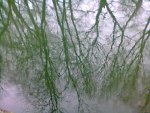Spring Not Yet Out

By markle
- 434 reads
As I write, spring is a suggestion, an absence. A few sunny days have slipped into memory, and what’s present now is grey, with a spatter of rain in the cold wind. I’ve just left Port Meadow in Oxford, where birds were singing, but in the depths of trees; daffodils were still sheathed in buds. From field to branch-end, colour’s shut out. Everything seems to have breathed in – lungs taut, all set – but when will the out-breath come?
Forty-eight hours ago, in Hampshire, this would have been no kind of question. In the pub garden in Tichbourne, the sun shone, the breeze was no more than a ruffling, and a song thrush was busy in the grass – good to see, despite the echo of Ted Hughes’ ruthless poem:
“Terrifying are the attent sleek thrushes on the lawn,
More coiled steel than living”
The midpoint of these two states, geographically, temporally and meteorologically, was on Greenham Common, southeast of Newbury. In the 1980s and 1990s it was the site of both a US nuclear bomber base and of extended protests against that base by the “Greenham Common Women”. It’s now a council-owned common, managed by the local Wildlife Trust. There was bright sun, but wind – the history makes me say it – straight from Russia.
On the site of the USAF base, all the gorse was in bloom, great shrubberies of star-scattered green. Children and dog walkers roamed the gravel paths, but for the most part the cropped grass was trodden only by animals – dogs of course, but also scraggy herds of cows. Birds sang and flitted among the bushes and the long white hairs of grass seed stalks left over from summer. They were nothing extraordinary species-wise, great tits, and robins, but their proliferation between the long flanks of the herbivores, and the chill-wrinkled surfaces of ponds, made me wonder if this was a foretaste of another world.
Some paleo-ecologists argue that Britain’s predominant pre-Neolithic landscape (say, 8,000 years ago, before major human impact) was “semi-open parkland”, where large herbivores browsed, interspersed by top predators (eg, wolves, here understudied by various breeds of domestic dog). The Common has not been decommissioned long enough for such a scene to have returned entirely naturally, but it’s tempting to imagine it doing so eventually, possibly in a world post-apocalypse, returning to an ungoverned state.
The fringes of the landscape help: the great blank earth-strengthened shoulders of the disused bomber hangars and the lifeless grey of the buildings on the base’s headquarters. Human culture as simply scar tissue, things getting on without us – there are many visions of this eventuality, but the one I recall most clearly is a cartoon I saw as a child (I even remember where – at my grandma’s house, in the back room). In it, an elder squirrel tells his children about Men, who had two glass eyes and tubes that led from their rubber faces down into their bellies. The last two killed each other in a swamp of mud and hate. And after that, the squirrel said, the world had grown green again.
I wanted to shout at the TV “No! we’re not all like that!” I wanted to hush him, and tell the story my way. But when I thought about it, I had the cold feeling that he might well have been right. I’ve not seen the cartoon since, but it’s still horribly vivid to me.
I wonder what the women of Greenham Common, persistent, brave protesters at the base’s fortified gates, would have made of my train of thought. The base commanders too.
As it turned out, the journey home didn’t go along the Newbury Bypass, the construction of which was the next generation’s radical epicentre. And it was difficult to imagine, despite the imposing structures on the skyline, the vision called up by Jorie Graham in her “What the End is For [Grand Forks, North Dakota]”:
“A boy like you took me out to see them,
the five hundred B52’s on alert on the runway,
fully loaded fully manned pointed in all the directions,
running every minute of every day.
They sound like a sickness of the inner ear”
The Wildlife Trust now puts up signs to prevent visitors trampling the eggs of ground-nesting birds. Is this a kind of victory for the world (natural and human) over the machinery of destruction? A local one, perhaps.
On grey Port Meadow today, as the rain danced around between clouds and grass, the silhouette of a red kite lifted slowly over the phalanx of waders trotting into the shallows of the flood-water lake. I turned to follow its glide over the grass, over the path, over mud. The shape of its beak sharpened against the sky’s frown. Slowly, slowly, it lost height, and disappeared against the leafless trees. I saw it fold, touch the ground and stop. Seconds later it was on wing again, taking the thermals, rising, the one clear shape above the treeline. The jackdaws surged up, shouting, to try to drive it off.
- Log in to post comments


